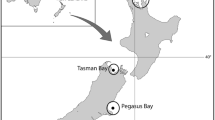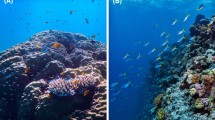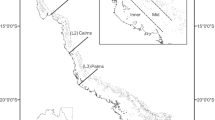Abstract.
We use age-based analyses to demonstrate consistent differences in growth, mortality, and longevity of coral reef fishes from similar habitats (exposed reef crests) 20 km apart. On outer-shelf reef crests of the northern Great Barrier Reef (GBR), size in four taxa of reef fishes (Chlorurus sordidus, Scarus frenatus, and S. niger and the acanthurid Acanthurus lineatus) was systematically and significantly smaller when compared with the same taxa on adjacent mid-shelf reef crests. Differences in size could be attributed to differences in growth between habitats (shelf positions). On outer reef crests the species examined had consistently lower size at age profiles and also reduced life spans compared with populations from mid-shelf reefs. To confirm this relationship, two of the most abundant species (C. sordidus and S. frenatus) were selected for more detailed spatial analysis of demographic patterns. Sampling adults of both taxa from reef crests on three mid- and three outer-shelf reefs revealed that most of the variation in growth was explained by shelf position, although C. sordidus also displayed differences in growth among mid-shelf reefs. We conclude that differences in body sizes across the continental shelf of the northern GBR are primarily determined by these trends in growth. Strong spatial patterns also existed in the mean ages of populations and longevity estimates for C. sordidus and S. frenatus between shelf positions. Both species on outer-shelf reefs displayed less variable cohort sizes, significantly reduced mean ages, and foreshortened longevity compared with populations on mid-shelf reefs. Furthermore, differences in these parameters were rare among replicate reefs within mid- and outer-continental-shelf positions. Age-based catch curves suggested that rates of S. frenatus natural mortality on the outer shelf were nearly twice as high as on the mid shelf. Visual surveys indicated that total scarid densities on outer-shelf reef crests are on average fourfold higher than for equivalent mid-shelf habitats. This fact, coupled with significantly reduced growth rates, reduced mean ages, and increased mortality rates, suggests that density-dependent processes may be responsible for observed differences among localities.
Similar content being viewed by others
Author information
Authors and Affiliations
Additional information
Electronic Publication
Rights and permissions
About this article
Cite this article
Gust, .N., Choat, .J. & Ackerman, .J. Demographic plasticity in tropical reef fishes. Marine Biology 140, 1039–1051 (2002). https://doi.org/10.1007/s00227-001-0773-6
Received:
Accepted:
Issue Date:
DOI: https://doi.org/10.1007/s00227-001-0773-6




